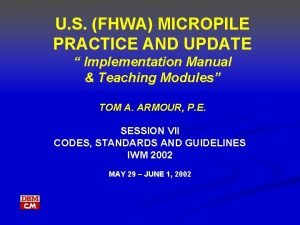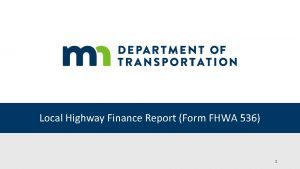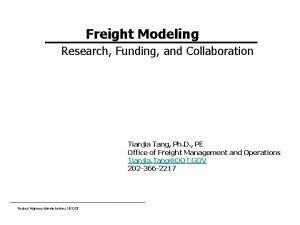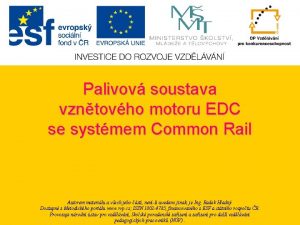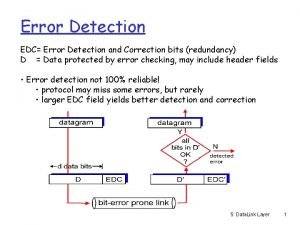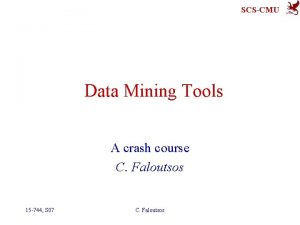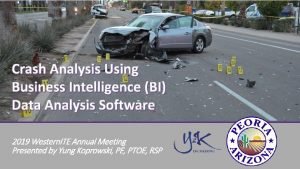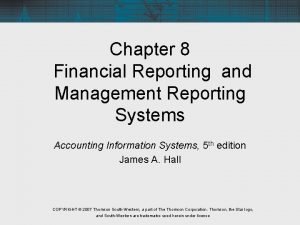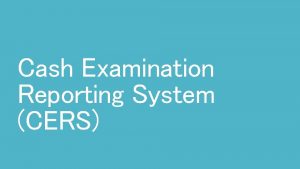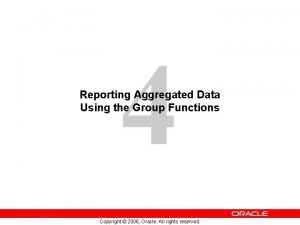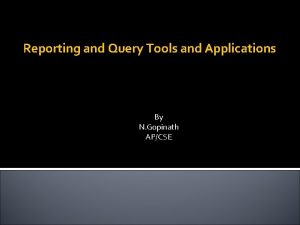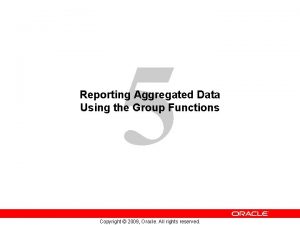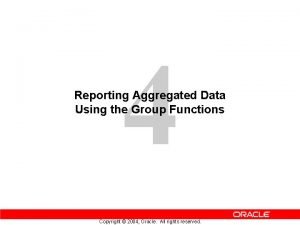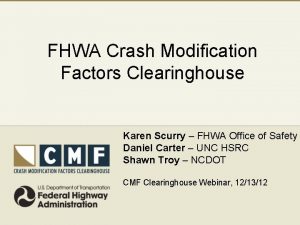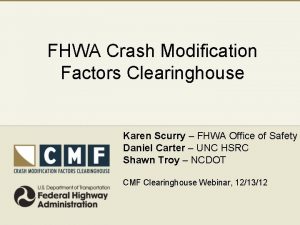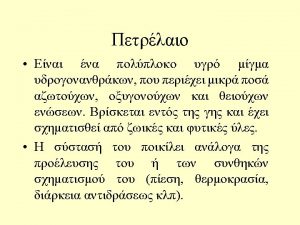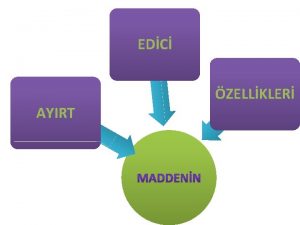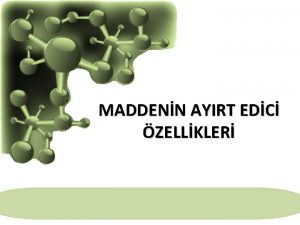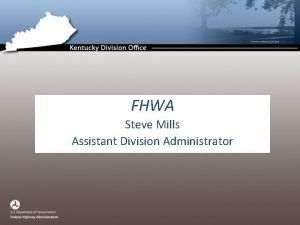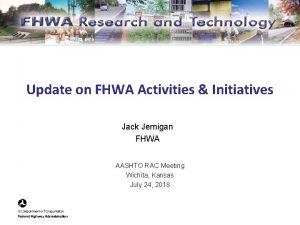Crash Reporting Systems TIM Data Elements FHWA EDC



















- Slides: 19

Crash Reporting Systems & TIM Data Elements FHWA EDC 4 Program Suggestions for Using Data to Improve Traffic Incident Management

TIM Data Elements Secondary Crashes Roadway Clearance Time (RCT) Incident Clearance Time (ICT) Responder Struck By Incidents Using Data to Improve Traffic Incident Management

What are Secondary Crashes? Secondary crashes are those that occur at the scene of an original incident or in the queue, including the opposite direction. • Secondary crashes are “crashes, ” meaning they are typically on a police report • Reference to “secondary” is new to crash reporting systems. • Presently, finding “secondary crashes” among all crashes in a data set is very difficult. Using Data to Improve Traffic Incident Management

Model Minimum Uniform Crash Criteria (MMUCC) • Historically secondary crashes were not included • 2017 version of the MMUCC will now include secondary crash as a crash data element via a “Yes/No” code • The NEW data element will be in MMUCC Section C 2, “Crash Classification” which is in the very first section CRASH DATA ELEMENTS that describe the overall characteristics of the crash • May take a few years for the data element to be included in statewide systems because of revision cycles Using Data to Improve Traffic Incident Management

Collecting Secondary Crashes – Kentucky Statewide Crash Report Kentucky was the first state to include secondary crashes on their statewide crash report in 2008. Using Data to Improve Traffic Incident Management

What is Roadway Clearance Time (RCT) Roadway clearance time is the time between the first recordable awareness of the incident by a responsible agency the time that all lanes are available for traffic flow. Using Data to Improve Traffic Incident Management

Model Minimum Uniform Crash Criteria (MMUCC) • Historically Roadway Clearance Time not included • 2017 version of the MMUCC will now include roadway clearance time as a date/time field when roadway • The NEW data element will be a subsection in MMUCC Section C 3 “Crash Date and Time” which is in the very first section CRASH DATA ELEMENTS that describe the overall characteristics of the crash • May take a few years for the data element to be included in statewide systems because of revision cycles Using Data to Improve Traffic Incident Management

Collecting Roadway Clearance Time (RCT) – Arizona DPS added RCT in their electronic reporting system, TRACS, and it was later included in the statewide crash reporting form in 2014. Using Data to Improve Traffic Incident Management

What is Incident Clearance Time (ICT)? ICT is the time between the first recordable awareness of the incident by a responsible agency and the time at which the last responder has left the scene. Using Data to Improve Traffic Incident Management

Model Minimum Uniform Crash Criteria (MMUCC) • Historically Incident Clearance Time (ICT) not included • 2017 version of the MMUCC DOES NOT include Incident Clearance Time (ICT) in guidelines • Like pre-5 th edition MMUCC approaches, states can voluntarily add ICT to their crash reports by adding a field for “Time Scene Cleared” Using Data to Improve Traffic Incident Management

Early Efforts to Collect Incident Clearance Time (ICT) – Florida Statewide Crash Report Like several states, Florida includes “Time Scene Cleared” as a data element on the statewide crash report format. Using Data to Improve Traffic Incident Management

What are Struck By Crashes? Responder vehicles are struck at incident scenes… We can typically find police vehicles in crash records When responders are struck as pedestrians, they are difficult to find among pedestrian crash data Using Data to Improve Traffic Incident Management

Why Struck By Crashes are important • Locating among all pedestrian traffic crashes in statewide data is very difficult • There is no national database or reporting system that captures responder struck by crashes • Understanding when, where, why, and how incident responders are struck can lead to improved training and equipment Using Data to Improve Traffic Incident Management

Model Minimum Uniform Crash Criteria (MMUCC) • Under the non-motorist data elements, Non- Motorist Action/Circumstance Prior to Crash (P 23) contains an attribute for: “Working in Trafficway (Incident Response)” • Most states do not currently include this attribute (AL, AK, AR, CT, FL, KY are exceptions) • Including this data element and attribute can lead to more accurate reporting of responder struck by incidents in states * Many state have “working in or on the road” which is not specific Using Data to Improve Traffic Incident Management

Current Struck By Data Element Efforts The Florida Traffic Crash Report Form contains the MMUCC recommended data element (since 2011). Using Data to Improve Traffic Incident Management

Current Struck By Data Element Efforts Year Total 2011 54 2012 60 2013 54 2014 67 2015 57 2016 79 Total 371 Florida Responder Struck By Crashes 2011 -2016 Includes 15 Responder Fatalities Using Data to Improve Traffic Incident Management

Model Minimum Uniform Crash Criteria (MMUCC) 5 th Edition Under the Persons data elements, Person Type (P 4) contains an element for “Pedestrian (P 4. 1)”, Incident Responder (P 4. 2), and if YES, Type of Incident Responder 01 EMS 02 Fire 03 Police 04 Tow Operator 05 Transportation 3 states currently have something similar (AK, MO, TN) Using Data to Improve Traffic Incident Management

Suggested Approach – State Crash Report Systems • Encourage agencies responsible for state crash reporting systems to plan for including the data elements in future system/report revisions, namely: MMUCC Reference Data Element C 2 C 3 “Crash Classification” Secondary Crash “Crash Date and Time” Roadway Cleared NM 2. 1 “Working in Trafficway (Incident Response)” P 4. 1 “Pedestrian” (Typically present) “Incident Responder? ” and “Yes, Type of Responder” with LIST P 4. 2 Using Data to Improve Traffic Incident Management

Grady Carrick FHWA EDC 4 Support Team gcarrick@enfenginc. com Using Data to Improve Traffic Incident Management 19
 Fhwa micropile
Fhwa micropile Fhwa form 536
Fhwa form 536 Fhwa freight
Fhwa freight Systém edc
Systém edc Correct edc
Correct edc Edchre
Edchre Edc carleton
Edc carleton Breakfast club edc
Breakfast club edc Data mining crash course
Data mining crash course Yung koprowski
Yung koprowski Explain the features of the gls and frs
Explain the features of the gls and frs Cash reporting systems
Cash reporting systems Hotel competitive set
Hotel competitive set Reporting aggregated data using the group functions
Reporting aggregated data using the group functions Reporting and query tools
Reporting and query tools Reporting aggregated data using the group functions
Reporting aggregated data using the group functions Reporting aggregated data using the group functions
Reporting aggregated data using the group functions Decision support systems and intelligent systems
Decision support systems and intelligent systems Dicapine
Dicapine Embedded systems vs cyber physical systems
Embedded systems vs cyber physical systems
